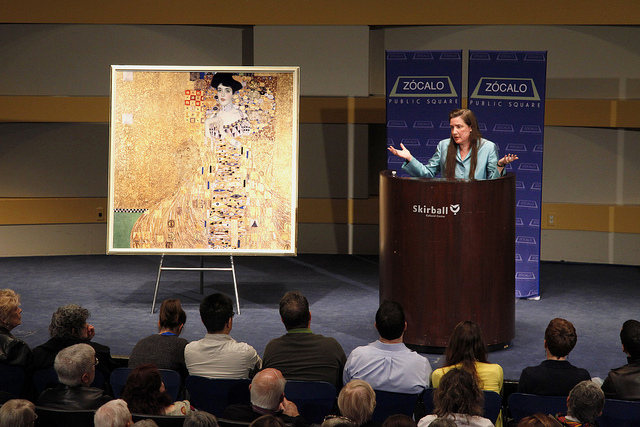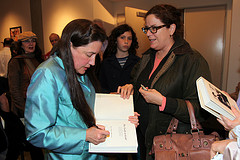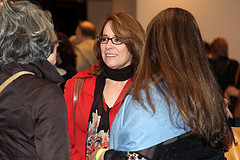
How did an interview with the retired owner of a Los Angeles dress shop about her Aunt Adele turn into a tale of sex and art, the Holocaust and restitution, and a legal battle of nearly a decade? Washington Post writer Anne-Marie O’Connor, author of The Lady in Gold: The Extraordinary Tale of Gustav Klimt’s Masterpiece, “Portrait of Adele Bloch-Bauer,” explained how she stumbled upon the long and twisted journey of one of Gustav Klimt’s most famous paintings, and why it captured her imagination. It’s a story that stretches from turn of the 20th-century Vienna to 21st century Los Angeles, with a cast of characters that includes Mark Twain and Billy Wilder.
Speaking to a full house at the Skirball Cultural Center–with audience members sitting everywhere, including the stage, which they shared with a reproduction of the painting–O’Connor began by explaining that Adele Bloch-Bauer’s portrait was lost into history by World War II. “It became a beautiful enigma like the Mona Lisa, but with a dramatic back story–and not a very well understood one, until recently,” she said.
O’Connor first heard about the painting in 2001, in a column in the Westside Weekly about a dress shop owner, Maria Altmann, who was the heir to a Gustav Klimt painting of her aunt that had been stolen by the Nazis. This wasn’t an uncommon story, except for the fact that the painting wasn’t locked away in a castle or an obscure private collection but in Austria’s national museum, the Belvedere, along with four other works of Klimt’s. And Altmann was suing to get it back.

O’Connor wasn’t interested in the painting itself at first, but as soon as she spoke with Maria Altmann–who was in her 80s at the time and still selling clothing out of her home–she was intrigued by Adele Bloch-Bauer.
Bloch-Bauer’s Vienna was “was an explosion of creativity,” “a mecca for really interesting people,” and a participant in the modernist movement that was sweeping Europe’s capitals. Women were on the vanguard of all these currents, collecting art, creating salons for intellectuals, and supporting a wide range of culture from Freud to avant-garde music. They were also following the lead of Austria’s dysfunctional royal family: having affairs and looking for independence.
Jews like Bloch-Bauer were also becoming more influential. One out of every 10 of the city’s residents was Jewish, and despite anti-Semitic backlash and even some violence, Viennese Jews were also thriving.

Adele Bloch-Bauer was young, beautiful, and married to a sugar baron twice her age. It was he who commissioned Klimt’s portrait. Eager to become involved in the city’s intellectual life, Adele started to invite people to her salon, including Mark Twain, who was living in Vienna at the time (and was rumored to be Jewish because he had so many Jewish friends) and Felix Salten, the author of Bambi, who at that time was infamous for writing a fictionalized memoir of a teenage prostitute.
But Klimt was the most magnetic star in Adele’s orbit, a handsome celebrity artist who was rebelling against the establishment, trying to make room for modern art in the city, and shocking everyone with his experimental art. Accused of creating pornography by his critics, Klimt turned to Adele and her friends–the new guard rather than the old–for patronage. Women, O’Connor explained, saw his drawings and paintings as rare representations of female sexuality. “This period was a little like the ’60s in some ways,” she said. “People wanted to change their lives.” Having a Klimt portrait in those days was a little risqué but also sensational.
Adele’s husband commissioned her portrait in 1903. Klimt spent three years drawing and painting Adele before the portrait appeared in 1907. It became a symbol of the Austrian empire that persisted even under Nazi rule, when its name was changed from “Portrait of Adele Bloch-Bauer” to “The Lady in Gold.” Adele and the other Jewish models who had been a source of much speculation–no one knows to this day what really happened between Adele and Klimt–had become anonymous.

Twenty percent of the art in Europe was stolen during World War II, including “The Lady in Gold,” which the Nazis put on display in the Belvedere. Adele had died before the war began, but her husband tried to get the painting back unsuccessfully before he died in 1945; his heirs were told that the family had donated the paintings, and the artworks remained in Austria.
In 2001, when she met Maria Altmann, O’Connor didn’t think her lawsuit would go anywhere. But Altmann and her lawyer, Randol Schoenberg, were determined to succeed, and the case wound its way through the courts until 2006, when the paintings were returned to the family’s heirs. Since this court case began, Austria has returned a dozen paintings to their owners, giving them up much more quickly than before.
Adele Bloch-Bauer’s portrait was purchased by Ronald Lauder for $135 million and is on display at his Neue Galerie in New York City. But the other paintings that were returned to the family were sold and then removed from public view–a development that raised further moral questions.
Watch full video here.
See more photos here.
Buy the book: Skylight Books, Amazon, Powell’s.
Read artists’ musings on their muses here.
*Photos by Aaron Salcido.




Send A Letter To the Editors